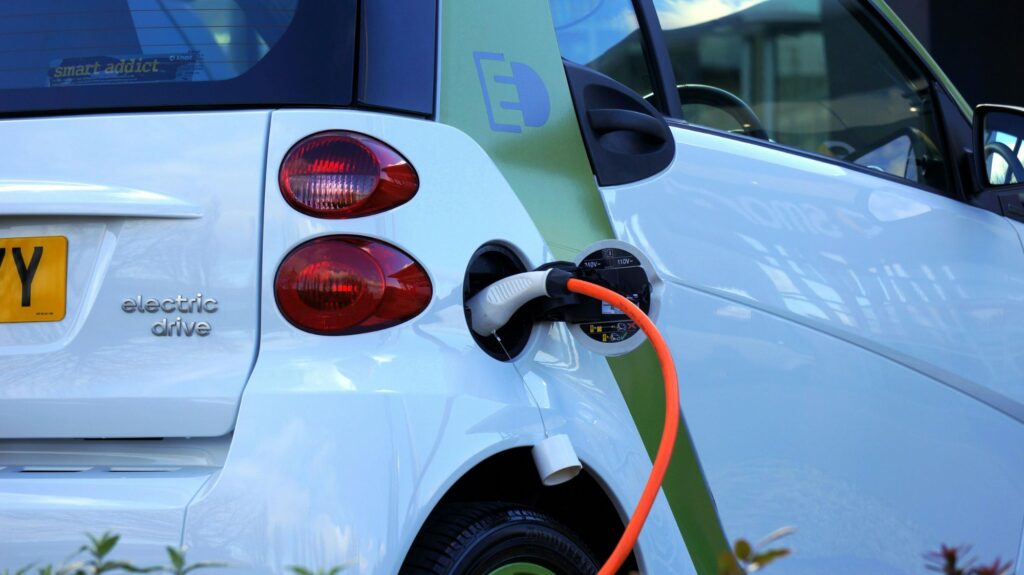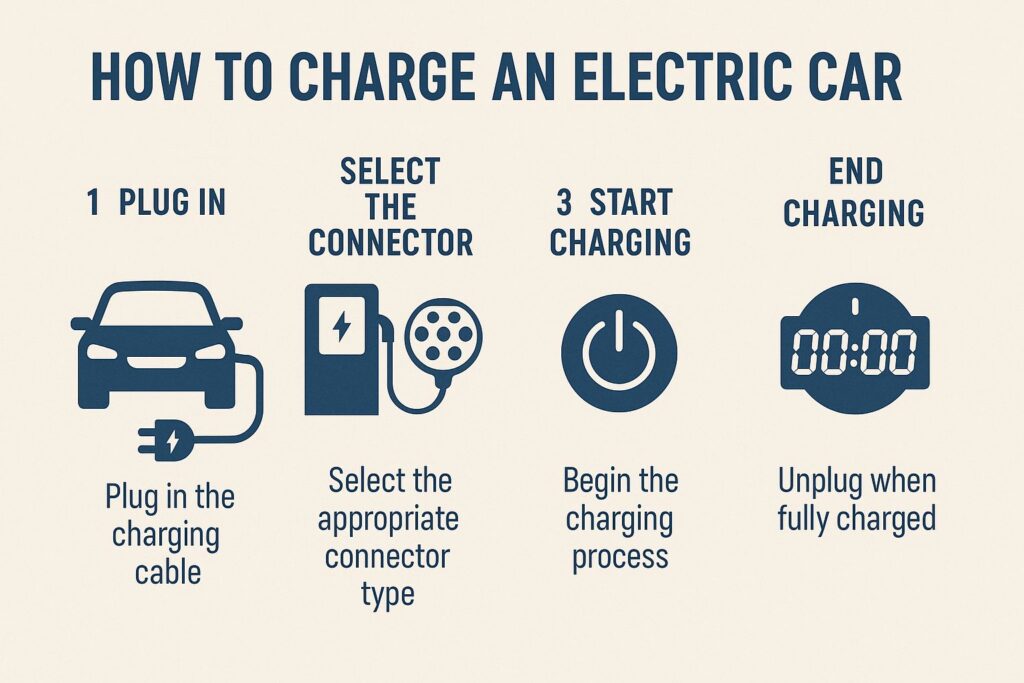Today, more people are choosing electric cars due to their many advantages. One of the biggest benefits is that electric vehicles (EVs) run without petrol or diesel, making them more eco-friendly and reducing air pollution. Since EVs produce zero tailpipe emissions, they help keep the environment cleaner. In addition, electric cars are more economical to operate, with lower running and maintenance costs compared to traditional fuel-powered vehicles. As fuel prices rise, EVs are becoming a smart and sustainable choice for modern drivers. In this article, we’ll explore the key details every beginner should know about electric cars.

How does it work
An electric vehicle (EV) uses electricity to charge its battery, which powers an electric motor to run the car—without using petrol or diesel.
Electric Vehicle Battery Capacity
EV batteries are large and powerful, typically made with lithium-ion technology. Battery size is measured in kilowatt-hours (kWh). Standard EV batteries usually range from 20 kWh to 100 kWh in capacity. The higher the kWh capacity of your EV battery, the longer the driving range, enabling you to cover more distance before requiring a recharge.
Eg:Tata Nexon EV: around 30–40 kWh.Tata punch EV Long Range about 35kwh.
Driving Range
Driving range is a key factor when choosing an electric vehicle (EV), and it largely depends on the battery capacity. Most standard electric cars in India offer a driving range between 180 km to 500 km per full charge, depending on the model, battery size, and driving conditions.Understanding EV battery capacity and its impact on range is essential for selecting a car that fits your daily commuting or long-distance travel needs.
| EV Model | Battery Capacity | Driving Range (Approx.) |
|---|---|---|
| Mercedes-Benz EQS 580 | 107.8 kWh | 857 km |
| Audi Q8 55 e-tron | 114 kWh | 600 km |
| Tata Nexon EV (Empowered+) | 46.08 kWh | 489 km |
| Tata Punch EV (Long Range) | 35 kWh | 365 km |
| MG ZS EV | 50.3 kWh | 461 km |
Electric Vehicle Battery Lifespan and Charging Duration
EV batteries are built to last between 1.5 to 2 lakh kilometers, and most standard EV manufacturers offer an 8-year warranty on the battery. One of the key benefits of electric cars is that they can be charged at home, typically taking around 7 to 10 hours with a regular AC charger. With a fast charger, the charging time reduces to about 1 to 2 hours. Ultra-fast chargers, also known as DC fast chargers, are even quicker but only compatible with certain EV models. For example, the Hyundai IONIQ 5 supports up to 350 kW ultra-fast charging and can charge from 10% to 80% in just 18 minutes.
Here’s a simple table showing the battery life (warranty) and charging time of some popular EV cars in India:
| EV Model | Battery Warranty | Home Charging Time | Fast Charging Time |
|---|---|---|---|
| Tata Nexon EV | 8 years / 1.6 lakh km | 7–9 hours (AC) | 56 mins (0–80% with 50 kW DC) |
| Hyundai IONIQ 5 | 8 years / 1.6 lakh km | 6–7 hours (AC) | 18 mins (10–80% with 350 kW DC) |
| MG ZS EV | 8 years / 1.5 lakh km | 6–8 hours (AC) | 60 mins (0–80% with 50 kW DC) |
| Kia EV6 | 8 years / 1.6 lakh km | 7 hours (AC) | 18 mins (10–80% with 350 kW DC) |
| Mercedes-Benz EQS 580 | 8 years / Unlimited km | 11 hours (AC) | 31 mins (10–80% with 200 kW DC) |
How to charge an electric car

Types of electric cars
1.Battery Electric Vehicle (BEV)
Battery Electric Vehicles (BEVs) are fully electric cars that do not require a petrol or diesel engine, making them a clean and efficient alternative to traditional vehicles. As fuel prices continue to rise, BEVs offer a more economical and environmentally friendly solution for daily commuting. These vehicles can be conveniently charged at home or at public EV charging stations.Popular BEV models include the Tata Nexon EV, Hyundai IONIQ 5, and Tesla Model 3.
2. Plug-in Hybrid Electric Vehicle (PHEV)
A Plug-in Hybrid Electric Vehicle (PHEV) uses both an internal combustion engine and an electric battery. It can seamlessly switch between fuel and electric power depending on driving conditions. PHEVs can be charged using home outlets or public EV charging stations.
A notable feature of PHEVs is their ability to run on electric power alone for a limited distance—typically between 30 km and 80 km, depending on the car model. Once the battery is depleted, the vehicle automatically switches to hybrid mode, using both the gasoline engine and electric motor to power the car. This allows for a total driving range of up to 640 km to 960 km, making PHEVs suitable for both short commutes and long trips.
3.Hybrid Electric Vehicle (HEV):
A Hybrid Electric Vehicle (HEV) uses both a petrol engine and an electric motor to save fuel and reduce pollution. Unlike a PHEV, it can’t be charged at a charging station. Instead, it charges itself while driving using the engine and braking. HEVs have a small battery and can’t go far using electricity alone. They are good for people who don’t want to worry about finding a place to charge their car..
Benefits of electric cars
Electric cars have lower maintenance and repair costs compared to internal combustion engine vehicles, thanks to fewer moving parts in the electric motor. Additionally, electric vehicles (EVs) have lower running costs since they don’t require petrol or diesel. In India, the cost of charging an EV at home typically ranges from ₹6 to ₹10 per kWh, while public charging stations charge between ₹8 and ₹15 per kWh, depending on the type of charger. The cost to fully charge an EV for a 100 km range can range from ₹100 to ₹150. Moreover, electric cars are environmentally friendly, as they reduce air pollution and contribute to a cleaner, greener planet. In addition to all these benefits, the Government of India also provides direct subsidies to make electric cars more affordable for buyers.
Government Subsidies & Incentives in India (2025)
- FAME II Scheme:
- Offers up to ₹10,000 per kWh of battery capacity.
- Capped at ₹1.5 lakh for electric four-wheelers.
- Valid until March 2025 (may be extended or replaced by FAME III).
- State-Level Incentives (varies by state):
- Delhi: Up to ₹1.5 lakh + registration & road tax exemption
- Maharashtra: ₹1 lakh subsidy + early buyer incentives
- Tamil Nadu: Full road tax exemption
- Gujarat: Up to ₹1.5 lakh subsidy + no registration fee
- Income Tax Benefits:
- Deduction of up to ₹1.5 lakh on interest paid on EV loans under Section 80EEB
- No Registration Fees:
- Central govt waives registration charges for electric vehicles
- Road Tax Waiver:
- Many states (like Kerala, UP, Karnataka) offer 50%–100% waiver
Challenges to know
1.High upfront cost
Electric cars usually cost more than petrol or diesel cars because of the battery, which is the most important and expensive part of the vehicle. This makes the starting price of an EV higher. However, over time, you can save money on fuel and maintenance. If you’re planning to buy an electric car, it’s good to be prepared for the higher initial cost.
2.Charging station availability
One of the common challenges of electric vehicle (EV) ownership is the limited availability of EV charging stations, especially when traveling to outstation areas or the outskirts of cities. In regions with underdeveloped charging infrastructure, finding a charging point can be difficult. To avoid range anxiety, it’s important to plan your trip in advance by checking your EV’s battery level and estimating the distance you plan to travel. Proper planning ensures a smooth and worry-free electric car journey.
3.Battery Replacement
Replacing an electric car battery can be a challenge. After 8 to 10 years, the battery may start to lose its efficiency and might need to be replaced. In India, the cost of a new EV battery usually ranges from ₹70,000 to ₹1,00,000, depending on the car model. Although many electric vehicles come with long battery warranties, it’s still smart to plan ahead for this possible expense in the future.
Note: Mahindra BE.6 now offers a lifetime battery warranty for first-time registered owners.
Conclusion
If you’re planning to buy an electric car, keep a few things in mind. Even though it costs more at first, it saves money over time because you don’t need petrol or diesel. It’s also better for the environment, so it’s a good choice for both your wallet and the planet.
Also read: Tata Curvv EV: Price, Features, Range, Launch Date & Everything You Need to Know
Frequently Asked Questions About Electric Cars
1. Are electric car charging stations free to use?
Some charging stations are free, especially at shopping malls or public places. But most stations charge a small fee based on how much electricity you use.
2. Can the battery of an electric car be replaced?
Yes, the battery in an electric car can be replaced. It usually lasts for many years, and if it becomes weak or damaged, it can be changed like any other part.
3. Which electric car has the longest driving range?
In India, the Hyundai Ioniq 5 and Tata Nexon EV Long Range are good options for long-distance travel.
4. How are electric car batteries made?
Electric car batteries are made using materials like lithium, nickel, and graphite. These materials are put together in factories under careful conditions to build safe and powerful batteries.
5. Can I charge an electric car at home?
Yes, you can easily charge an electric car at home. You can use a regular plug or install a special charger for faster charging.
![[freshyvibes] website logo](https://freshyvibes.in/wp-content/uploads/2025/05/cropped-Green-and-Beige-Classic-Elegant-Nature-Foundation-Logo_20250503_040900_0000.png)